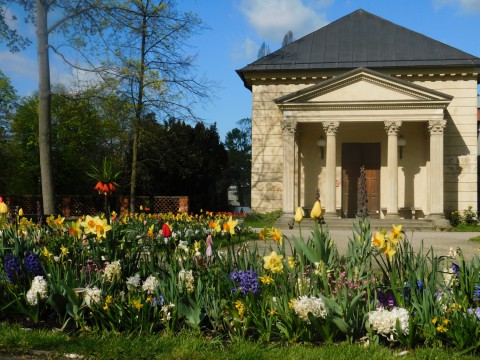Display “Oriental Spring: Plants of the Ottoman Empire in the Wilanów Gardens” | park | mid-April – May 2023
The Museum of King Jan III’s Palace at Wilanów and the University of Warsaw are hosting this year’s 17th International Congress of Turkish Art (ICTA). On this occasion, we invite you to the park for a unique display of spring plants of the Ottoman Empire.
Garden art was one of the areas that reflected the wealth, abundance and wide influence of the Ottoman Empire. Poles visiting Constantinople and other royal cities were impressed by the gardens and exotic plants found there. The Ottomans’ love of flowers was so widespread that they were called a nation of gardeners. Thanks to numerous political and trade contacts, many plant species were imported to the Polish-Lithuanian Commonwealth in the 16th to 18th centuries, including tulips, imperial fritillaries, eastern hyacinths and daffodils. Although the memory of their origin has passed, they remained one of the most loved spring plants to this day.
The display in the Wilanów gardens is intended as a reminder of the history of the plants of the Ottoman Empire and their importance in the gardens of the former Commonwealth. The beds were planted with 17,000 bulbous plants and 15,000 annual plants, including imperial fritillaries, tulips, garden violets, eastern hyacinths as well as alpine forget-me-nots. The composition and colours of their flowers, representing shades of yellow, red, white and blue, are inspired by Ottoman works of art from the Wilanów collection as well as the collections of Turkish museums and libraries, including Topkapı Palace, Istanbul University Library and the Museum of Turkish and Islamic Art in Istanbul.
The floral compositions of the Northern Garden refer to the colours of traditional İznik tiles and vessels, considered as one of the greatest achievements of the Ottoman ceramic art. They were painted by the artists with geometric patterns, floral motifs, as well as birds and other animals. These works include an early 17th-century plate from the Wilanów collection (Wil.5664) with a fanciful representation of a rose, a tulip and a saz leaf.
The colourful flowerbeds around the Orangery reflect the character of the textiles. Densely woven plantings of tulips and forget-me-nots create an embroidery structure familiar from Ottoman fabrics, carpets and tents. The collection of the Museum of King Jan III’s Palace at Wilanów contains, among others, an embroidered hanging (Wil.5095) and an appliqued fabric (Wil.5625) representing this style. A Turkish tent, which disappeared at the end of 1944, was once displayed in the Wilanów Orangery.
The two flower beds next to the eagle column in the Northern Landscape Park are a tribute to the Ottoman illumination, i.e. the intricate gilded decorations of books and albums. An excellent example of such illuminations can be found in a Quran from 1645 kept in the Museum’s collection (Wil.5478). Yellow and orange plantings of imperial fritillaries, tulips and hyacinths create concentric geometric patterns.
The display closes with two flower beds by the Pump House by Lake Wilanów: their white and pink colours refer to the Ottoman miniatures depicting scenes set in the Sultan’s gardens. They are dominated by tulips, whose name, according to tradition, was invented in 1554 by Ogier Ghiselin de Busbecq, ambassador of Emperor Ferdinand I of Habsburg in Constantinople. Their flowers were to remind him of a turban called tulipano in Italian. Hence, in the former Polish-Lithuanian Commonwealth, the plant was referred to as “eastern zawój” or “Turkish zawój” (“zawój” is one of words for turban).
The display “Oriental Spring: Plants of the Ottoman Empire in the Wilanów Gardens” was prepared on the occasion of the 17th International Congress of Turkish Art (ICTA), co-organised by the Museum of King Jan III’s Palace at Wilanów and the University of Warsaw. The congress will take place from 18 to 21 September 2023.
We also encourage you to admire the other spring plants presented in the palace gardens. Please do not touch or devastate the plants.
Time: mid-April to May 2023
Venue: park (North Garden, Orangery Garden, North Landscape Park)
Admission: included in the park ticket
Event under the patronage of the European Route of Historic Gardens

suggested

What you can see in the park
Wilanów Palace & ParkLocated south of Warsaw, the Wilanów Palace & Park concludes the series of royal residences erected on …

What you can see in the palace
When Jan Sobieski accepted the royal title in 1676 and took the throne as Jan III, the Royal Castle, austere …

















